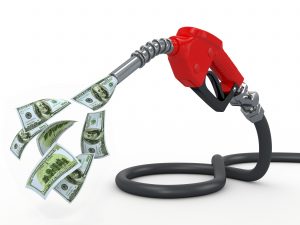 If you’re feeling the squeeze every time you fill up your tank, we have some time-tested tips for making the experience less painful. We can’t turn back the clock or change global events that drive dramatic price increases, but we can share some tips to help ease the blow!
If you’re feeling the squeeze every time you fill up your tank, we have some time-tested tips for making the experience less painful. We can’t turn back the clock or change global events that drive dramatic price increases, but we can share some tips to help ease the blow!
On their own, each of these tips only makes a small difference, but implementing a few at a time in a collaborative way, will ultimately keep your pockets full.
1. Choose regular-grade gas.
Unless you’re driving a high-performance sports car, you don’t need high-performance gas. Higher-octane fuel options don’t deliver more value unless your car is specifically designed to run on them.
2. Fill up at the beginning of the week.
According to a 2019 study by GasBuddy, Monday and Tuesday are the best days to fill up, and Wednesday and Thursday are the best days to top off your tank. To save, avoid the pump on the weekends.
3. Take advantage of gas discounts and rewards programs.
There are a lot of different fuel rewards programs out there, many of them available through gas station chains and grocery stores. Warehouse clubs, like Costco and Sam’s Club, usually offer discounted prices to their members. And there are many other programs through grocery retailers like Stop & Shop and Price Chopper that provide gas discounts when you spend a certain amount on your groceries.
4. Pay with cash.
Some gas stations offer a lower per-gallon price if you’re willing to pay with cash instead of a card. Keep an eye out for these offers, and take advantage when you can.
5. Get cash back.
Use a cash-back or points-based rewards card to buy your gas. This way, you can at least earn some money back with each fill-up. And some points programs will allow you to cash in points for gas. Just make sure to read the fine print and keep ahead of the monthly due date to avoid interest charges and other fees.
6. Find the cheapest gas with an app.
“There’s an app for that.” Mobile apps like GasBuddy and Gas Guru are available for both Android and iOS devices, and will help you locate the least expensive gas in your area. The AAA Mobile app is another great resource. And, in a pinch, you can use Google Maps and search for nearby gas stations.
7. Keep those tires well inflated.
According to the U.S. Department of Energy, “You can improve your gas mileage by 0.6% on average—up to 3% in some cases—by keeping your tires inflated to the proper pressure. Under-inflated tires can lower gas mileage by about 0.2% for every 1 psi drop in the average pressure of all tires.” Check your car’s owner manual to determine the correct tire pressure for your vehicle, and then use a tire pressure gauge to see if your tires need adjusting.
8. Don’t let oil changes and other maintenance slide.
With all the extra expense of gas, it can be tempting to skip an oil change or other routine maintenance, but don’t fall into that trap. A well-maintained car runs more efficiently, which means you get more out of each gallon of gas.
9. Make sure your tank is tightly capped.
In addition to costing you money, gas evaporating from your tank is bad for the environment. A gas cap with a damaged or missing seal allows gas to evaporate before you even have a chance to get your money’s worth.
10. Lighten your load.
It’s great to have emergency supplies in your car, just in case. But the heavier your vehicle is, the worse your gas mileage will be. Take a minute to look through your back seat, trunk, and any other storage areas to make sure you’re not hauling extraneous items that might be slowing you down.
11. Ditch the racks.
If you have bike, ski, or boat racks installed that you aren’t currently using, consider taking them off to improve your car’s aerodynamics and also eliminate unnecessary weight.
12. Find the most efficient route.
With Google Maps and other tools, it’s easy to determine the most direct path to your destination. Plan ahead, especially when you’re driving in an unfamiliar area. And even when you know exactly where you’re going, take the time to consider how you might be able to reduce your drive time. If you’re running errands at multiple stores, for instance, think about which route will get you from store to store and home again in as few miles as possible.
13. Avoid idling.
Idling unnecessarily is like throwing money into the wind. And it’s also bad for the environment. Don’t start your car until you’re completely ready to go—navigation on, coffee in the holder, kids all buckled in. And, whenever possible, turn your car off when you’re waiting, like at school pickups or if you’re meeting someone.
14. Ease up to stop lights.
Cars use up a lot of fuel moving forward out of a dead stop, so you can conserve fuel by slowing down way ahead of a planned stop and coasting to intersections. If you time it right, you won’t need to come to a complete stop.
15. Reduce your highway speed.
The U.S. Department of Energy has this to say about how your speed can affect your car’s efficiency, “While each vehicle reaches its optimal fuel economy at a different speed (or range of speeds), gas mileage usually decreases rapidly at speeds above 50 mph. You can assume that each 5 mph you drive over 50 mph is like paying an additional $0.30 per gallon for gas.”
We will get over this gas price massacre sooner than later, but until then, we’ve done our due diligence in informing you on what can work on saving you some extra bucks at the pump. With the money you save, go on into the store and treat yourself to a cup of coffee, you’ve earned it!
Related Posts:
Key Tips for Living With Hearing Loss
Forget Your Reading Glasses? Here’s Your Backup Plan
Stay Healthy and Happy — Volunteer!
Put Some Extra ‘Zing’ in Your Spring Cleaning
 Connecticut Estate Planning Attorneys Blog
Connecticut Estate Planning Attorneys Blog


